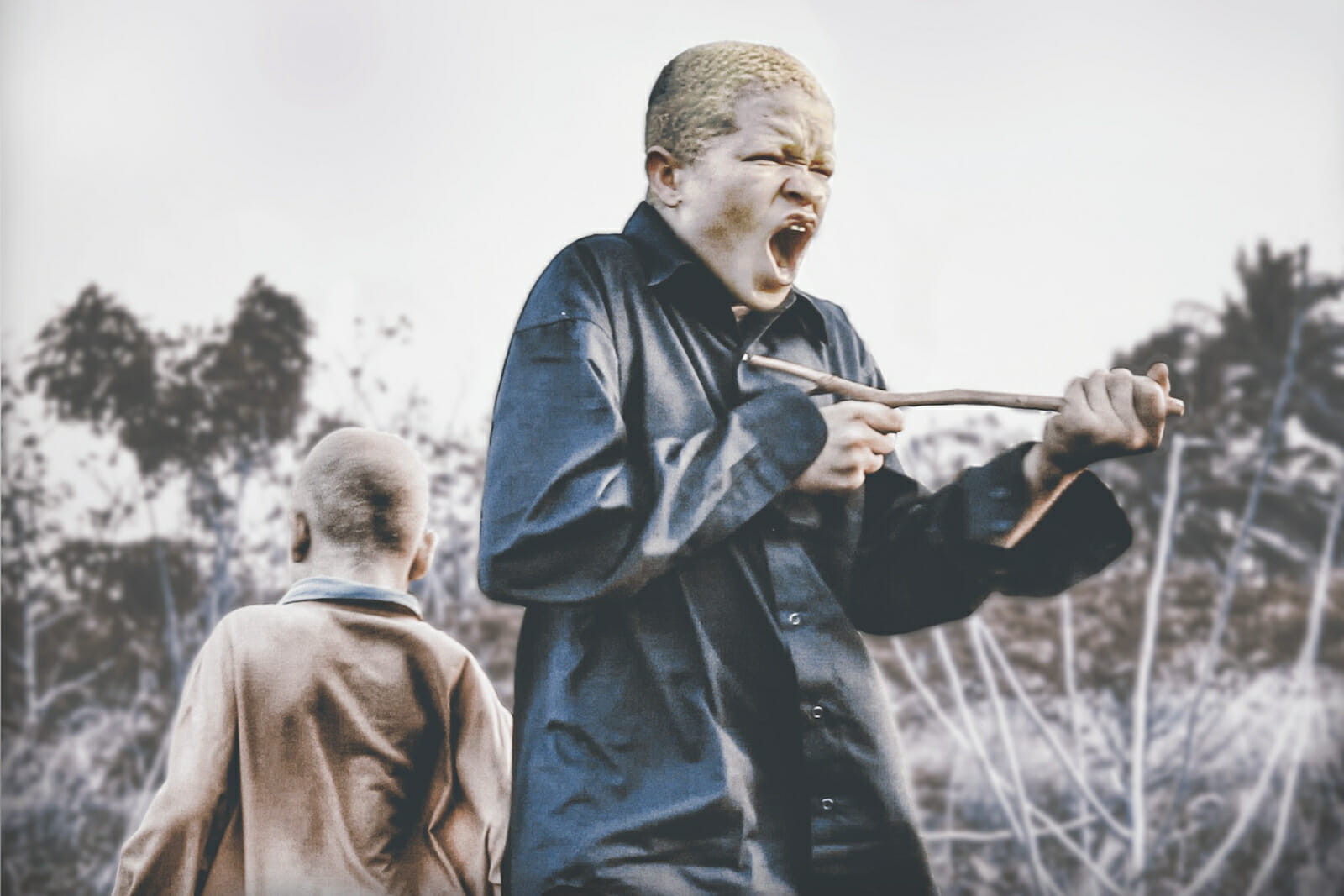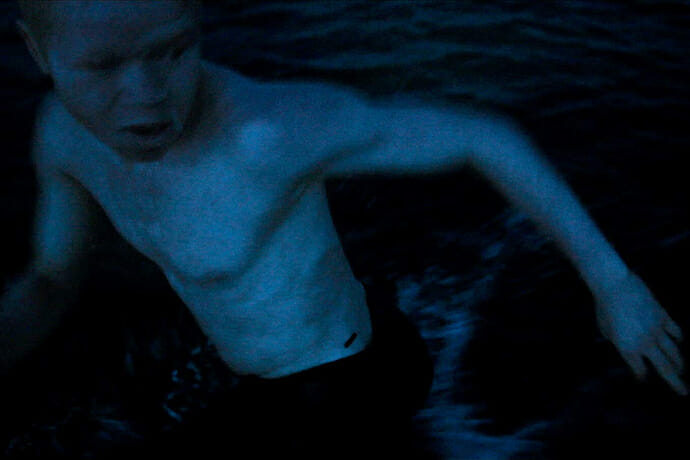
Noaz Deshe on his Film, ‘White Shadow’: A Fight for Survival in East Africa
“Albinos don’t die, they just disappear.”
Director Noaz Deshe’s debut feature film, White Shadow, is about the plight of an albino boy, Alias, played by newcomer, Hamisi Bazili, living in Tanzania, whose father (Tito D. Ntanga) is hacked to death by locals for his meat and organs which are believed to hold special powers. It is powerful in it’s realism. The film very well could have been told through a documentary format but in doing so it would have lost its power of persuasion. The film is premiering at the Sundance Film Festival.
After Alias’s albino father is murdered in the dark of night, his mother (Riziki Ally) sends the young boy off to live with her brother, Kosmos (James Gayo), Alias’s uncle, in the city believing that this will protect the young man. Unfortunately he faces as many risks stemming from superstitions involving albinos in the city as he did in the country. His life in the city initially involves the mundane, selling basically junk items like CDs and sunglasses for his bully uncle. The plot involving his burgeoning relationship with his uncle’s daughter, Antoinette, is especially touching.
Superstitions are dangerous, and for albinos living in Tanzania, Congo and Kenya, they are deadly. While the plight of albinos has been covered in the Western media, films like White Shadow help keep the focus on a deadly problem, that local governments either care little about or are unsure how to address.
Local witch doctors convince locals of the healing powers of albino meat and organs and offer significant cash payments for their delivery. Locals then hack off arms, legs and genitalia. The body parts are turned into a medicine which they believe will cure many ailments and bring good luck.
The payments can range anywhere from $500 to $5,000. For countries where annual incomes are so little, this offers significant inducements to commit ghastly murders.
The villains of the film, are Kosmos (the uncle), who preys on his young relative, and the witch doctor shown. While the film does get bogged down somewhat, and its running time is a little too long, as it explores a young man’s fight for survival, the viewer never forgets the dangers he faces daily.
The following interview was conducted via email due to the fact that Noaz Deshe is currently attending the Sundance Film Festival.
Are there albino communities where you filmed?
Yes, there are a few organizations that support albino awareness. The most prominent and well funded is Under the Same Sun who has Vicky Ntema on its Board. Vicky won a Courage in Journalism Award from the International Women’s Media Foundation for catching a witch doctor on a secret camera trying to sell her albino body parts. I was fortunate to meet Vicky as she was a big inspiration. Also ARCT (The Albino Revolution Cultural Troupe) that is managed by Tito Ntanga who plays the father of the lead character in the film. His group travels and performs dances and songs to bring awareness to the plight of albinos. TAS (Tanzania Albino Society) is also very well known.
Did you turn to any of the albino communities for help when you were making the film?
Apart from ARCT that collaborated closely in the casting as well, we met with everyone we heard we should but mainly in the research phase and to make sure they are aware of the film being made and what it would be. Since it is not a documentary other rules apply and you have a free hand in how you depict a fictional character.
Can you explain what got you interested in the subject of the film?
The subject or story could be 300 years old, it’s not the first time in our history that a minority is prosecuted with the additive of myth and superstition. In 2010, a friend, Matthias Luthardt (co-producer), invited me to join him to teach a short film course in Dar es Salaam, Tanzania’s capital in East Africa. The Goethe Institute Tanzania and Alliance Française were hosting us, and the objective was to make a short film with a group of 40 local talents that had signed up.

Having a background as a researcher for other films, I began by consuming all sources of local news and blogs and with that I very quickly encountered an issue which takes the center stage in Tanzania’s media, the human hunting and persecution of Tanzanian albinos for witchcraft. From there, the idea for the film came very quickly and I met many collaborators through the initial course and workshop. When you have an idea it dictates the ways it should come to life.
In the beginning of the film, Alias’s father is essentially being hunted at night before being hacked to death. Was that scene inspired by a true story?
Yes, it is a combination of two of my research stories and Hamisi Bazili. In reality the incidents are much worse and their ritualistic side goes beyond what we perceive as human behavior.
With the actors involved, and especially Hamisi Bazili, what went into casting the film?
When we began casting the film, we set up auditions and workshops. Alliance Française gave us their building, and every night it was full of people playing out scenes from the film. Nassos Chatzopoulos, a Greek Tanzanian director and cameraman, who participated in the workshop, was our anchor in Dar Es Salaam. He opened his home to us and brought all his friends and colleagues to help us. He introduced me to Hashim Rubanza who helped me cast the film.
Hashim and I would go during rush hour to a ferry that crosses from the rural to modern part of the city. There we would street cast, based on gut feelings. For example, we walked into the fish market and saw a guy who was sitting on a chair bossing all the other fishermen and being very calm, and we invited him to be one of the people in the gang. It was an exhilarating guessing game – we challenged each other on how many interesting strangers we could convince to come to a screen test. We developed a spiel, and after a few hours we had a routine. Everyday we played out abduction scenes and bank robberies, home invasions and love spats with people that came from our street adventures. There was also Andrew Panja, a great local character and our “fixer” who brought more performers, usually his relatives. We ended up casting his brother.
Tito, who plays Alias’ father in the film, was the only person in the crew with regular stage experience, as he is the head of a dance and song group that brings awareness to the albino cause, called ARCT. We traveled around different cultural centers looking for the kids that would play Alias and Salum. We did dream workshops where we first did a short interview then we would talk about dreams. The kids that stuck out as storytellers stayed. We were very lucky to meet Hamisi (who plays Alias) in a workshop we did in collaboration with Tito. Hamisi was waiting for us, prepared with a song he wrote about his life.
We kept filming with him for a few days to make sure he could work with preconditioned situations. He was phenomenal. When I told him that we would make the film with him, he nodded. A girl in the room asked him “Why are you not smiling? Aren’t you happy?” He answered, “It’s not necessary to smile in order to show happiness” and then he laughed. That was it.
Was there a particular scene that was difficult to film, either for the actors or crew?
All the scenes where challenging but never dangerous. What was hard, in particular, in the beginning of the shoot, non-actors do not contain the idea that they might have to repeat the same thing many times until it’s honest or works. But once we built a rhythm of work it became a very playful experience and the cast was pushing for their own excellence and became very comfortable to perform and play. That was essential because they could bring any new cast member into that atmosphere. It was hard to watch scenes evolve where the kids break emotionally but they gave their heart and soul in the moment and never gave up.
One day we changed our schedule at the last moment and went to shoot in a different location. Where we did not go, a lion killed ten people. The army shot him. I keep thinking about this lion running through a very poor and condensed area. Maybe that was his first time and he is realizing that humans are easy to catch, their skin is not tough like wild animals, perhaps when it comes down to it he needs to do this more often because he has been pushed away from his natural habitat, and at the moment of his eureka, he gets shot by the army.
There were many difficult moments…
One night we heard artillery and found out that an old military weapons depot was exploding. Missiles flew into the international airport and surrounding villages. One of the kids who was acting in the film, Willy Wilson, had to escape his home when bombs where landing on his head. He got hurt and would not speak for a month. Crewmembers contracted malaria and aggressive skin rashes, severe food poisoning. And never for one moment did I think, we cannot do it. The doubts and worries keep you alert and solving problems. The entire process is adjusting to new realities every day.
The entire crew was extremely committed. Everyone was on a mission pushing each other to make it work. No one questioned the reasons or way to make it. We kept up that energy and it kept us going. There were times we had to shoot with many people. It is a big test for your conviction. If the idea works, then you don’t think twice about knocking on every door one morning in a faraway village, in a place you don’t know and don’t speak the language properly. You knock on every door and announce a village meeting and then bring everyone into the process and make something out of nothing, with a group of people you met a few hours ago and suddenly all agree to share one fantasy. And everyone has his own. It is, in its positive form, the most playful and beautiful thing humans can do to drop everything that weighs them down and commit to a total fantasy and play.
How did you decide on Tanzania when the issue of albino killings is also a problem in Kenya and Congo?
Tanzania is not mentioned in the film apart from the location credits. It is an East African and partly West African subject. Also, Tanzania is beautiful country with a stable government and part from very specific problems it is not a violent country. The religious conflicts between ruling factions are relatively tame. Also, it was the country with the most information about the subject and apparently it is estimated that over 150,000 albinos live in Tanzania and with that it is believed that Tanzania has the largest population of albinos in Africa.
Did you run into significant pushback from locals?
No. We casted very carefully and methodically with the idea that the cast and crew represent a collaboration with all factions of society and if we collaborate on the ideas and check facts all the time then we are a local crew that is representing a local point of view.
You have to keep testing that every moment. You shoot a scene and ask your sound man “Is that how it’s said? Does it sound honest? Is it credible?” keep testing the moment and continue.
Did local governments where you filmed protest, considering the subject matter?
Not at all, we had great support from the government to make a fiction film about the subject. I do believe that the Tanzanian government benefits from dealing with the issue publicly; it shows faith in their campaign against it. We informed the minister and the police commissionaire and then casted police officers in the film.
You have to embrace the idea that if you bring the whole community into your creative process and they all perform then you are just joining something that is already there, that it needed to be told and we were there to help it become a film.
Is the way you ended the film typical or an outlier of how some local villages have dealt with albino killings?
It is typical that in the rural areas the police do not execute justice but a local vigilantly force called Sungu Sungu does. The villagers exact their own justice. One of the worst things you can experience is when someone shouts Muizi (thief). Immediately everyone within an audible distance will drop everything they are doing, run to the petrol station, get a gas can, a tire, and a mob will chase the person that stole maybe a bag of rice, stone him, beat him with their shoes, put a tire on his head and burn him.
I have witnessed mob justice a few times in East Africa where the police do not intervene. But you must understand that stealing in certain regions is equal to murder. The mob justice scenes in the film are inspired by stories I heard and that I researched the way mob justice would unfold. In this case, we had a meeting and discussion with the entire village and we asked them how would it happen? What would you do? Then we let it happen with being very careful and planned and it was as if we showed up to document it. The entire process of filming had a lot to do with setting up situations and then forgetting you set it up, and just show up to document it as if it’s happening.
What is the feedback?
Very strong, people come to us in the street to share their experiences, they want to understand how it was made, and are worried for Hamis who plays Alias. We are in touch with him often.
Do you note any changes in the way some African societies view albinos?
Yes there has been a lot of progress a lot of thanks to the relentless awareness campaign by Under the Same Sun.
Essentially who are the real villains in your movie? Are the witch doctors that prey on ignorance just as guilty as the murders?
We go through an experience in which all people fall into a trap of their struggle for survival. Even the witch doctor and the killers are victims of circumstance. The film cannot judge.
Finally, is there more of a concerted effort by local and national governments to dispel superstitions surrounding albinos?
There is a very big crackdown in Dar es Salaam and Mwanza but in the rural areas the government lacks the resources to educate a very large population that sees this as a get rich quick solution. Or as a true source of luck. The police force counts on the villages to do justice as they wish. Very often a thief will run into the police station, as it is the only place that will protect him.

